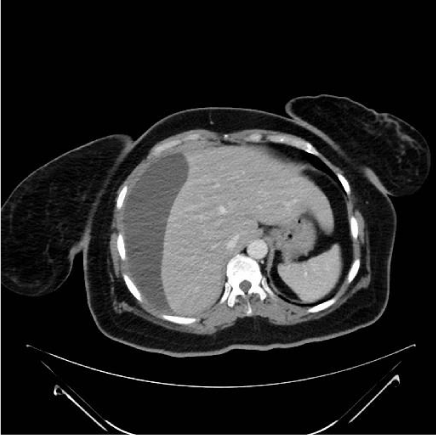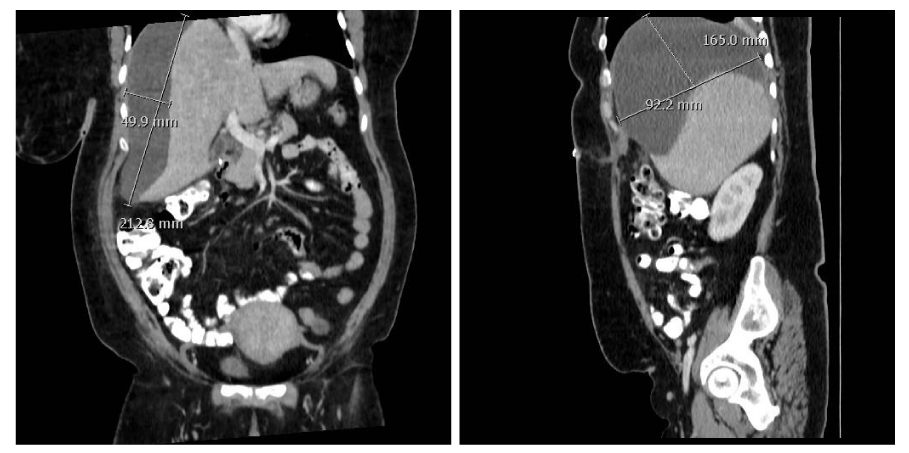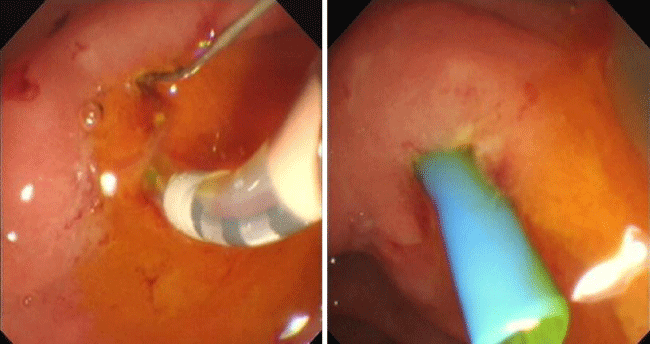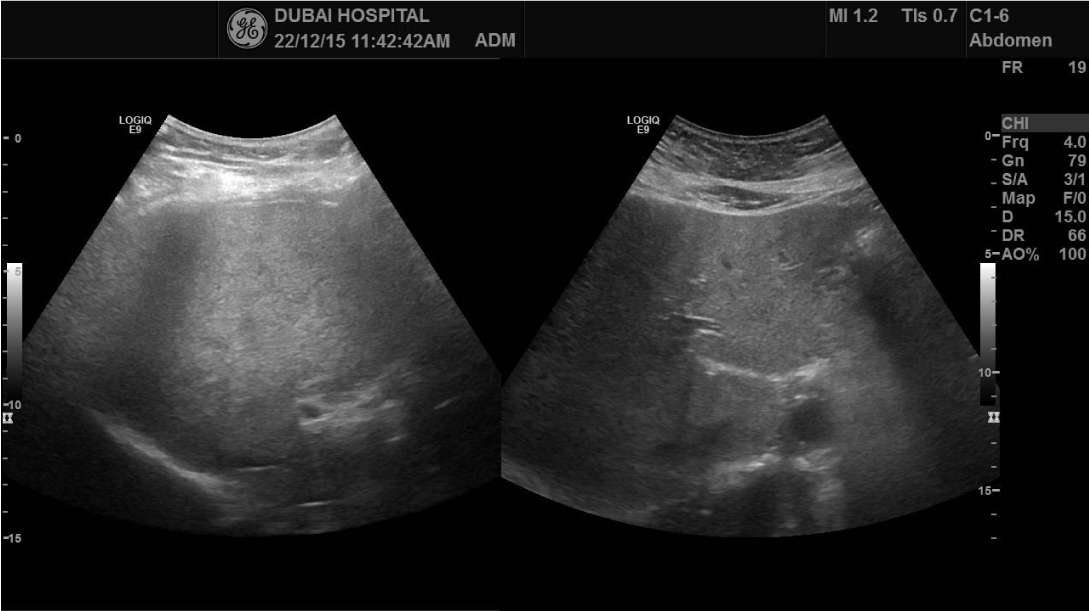Archives of Hepatitis Research
A rare case of hepatic sub capsular biloma after cholecystectomy treated by percutaneous drainage and endoscopic biliary stenting: A case report
Naureen Sameera*, Ishaq Aliya, Itu Lizica, Al Awa Arfan, Ghazi Esaaf, Zaid Abdul Aziz, Siddhart Sankar Das, Feras Al Khitab and Syed Javed
Cite this as
Sameera N, Aliya I, Lizica I, Arfan AA, Esaaf G, et al. (2019) A rare case of hepatic sub capsular biloma after cholecystectomy treated by percutaneous drainage and endoscopic biliary stenting: A case report. Arch Hepat Res 5(1): 027-029. DOI: 10.17352/ahr.000024Bilomas are localized collections of bile which usually happen post-operatively from an injured cystic or bile duct and most of the biloma collections are in the sub hepatic space. We describe a rare case of hepatic subcapsular biloma after open cholecystectomy which was successfully treated by percutaneous drainage.
Background
Bile leak after laparoscopic open or cholecystectomy usually happens due to unidentified minor biliary injury, however, sometimes it can reveal a major duct injury as well. Mostly the cause is iatrogenic injury and trauma, and mostly located in the sub-hepatic space. More than 50% cases originate from the cystic duct [1]. Hepatic sub capsular bilomas are mostly happening as a complication after cholecystectomy. We describe an interesting case of a 46-year-old woman, who was electively admitted for laparoscopic cholecystectomy for symptomatic gallstones and due to peroperative findings of a mass formation, underwent open cholecystectomy, a week later developed fever and right upper quadrant abdominal pain and diagnosed by a Computed Tomography (CT) and ultrasound as subcapsular biloma and, which was successfully treated by percutaneous drainage and Endoscopic Retrograde Cholangiopancreatography (ERCP). There are some cases reported in the literature about this complication after laparoscopic cholecystectomy [2], but in our institute this complication was dealt in for the first time, and was successfully managed non-surgically.
Case Presentation
A 46-year-old Pakistani lady was electively admitted for cholecystectomy due to symptomatic gallstones and repeated episodes of cholecystitis in the near past. Her past history was unremarkable in terms of any previous surgery or chronic illness. Peroperative laparoscopic findings revealed peri-cholecystic adhesions and mass formation, so the decision was to convert to open cholecystectomy. Due to the extensive adhesions noted at the level of callot’s triangle making anatomy identification extremely difficult, subtotal cholecystectomy was performed, due to flogistic pseudo-tumor as e result of previous attacks of cholecystitis.
Post operatively, the patient remained in hospital for pain control and chest physiotherapy. On the seventh post-operative day, she became pyrexial and started to complain of increased pain in the right upper quadrant of her abdomen. On examination, she had a temperature of 38 degrees, a pulse rate of 100(bpm) and a blood pressure 140/80mm Hg. Abdominal examination was unremarkable apart from mild tenderness around her cholecystectomy scar. Laboratory data revealed hemoglobin of 8.7g/dl, white blood cells of 15,600/mm3 with neutrophilia 83%. Liver enzymes showed a total bilirubin of 0.7mg/dl; SGPT was 35U/L and alkaline phosphatase was 320U/L. Ultrasonography (US) of the abdomen revealed a large fluid-filled collection in the right lobe of the liver extending laterally without any free intra-abdominal fluid. Thoraco-abdominal Computed Tomography (CT) confirmed the results of the US and concluded a large hepatic sub capsular biloma measuring (20cm×4cm×4.5cm). Based on the imaging findings, we made a decision to perform a percutaneous US guided drainage of the collection which drained 800ml of frank bile (Figures 1-5).
After draining the bile, a drainage catheter was positioned and left in place. Meanwhile the patient was also referred to Gastroenterology as the alkaline phosphatase level was still high and decision of endoscopic retrograde cholangiopancreatography (ERCP) was done on 14th postoperative day with sphincterotomy and 7 Fr plastic stent placement with good bile drainage internally. The external catheter drained more than 500 ml of bile over 5 days and it was removed 5 days later when the output was gradually ceased and, a follow up US showed a near-complete resolution. No complication occurred. The patient had repeat ERCP after 10 weeks and uneventful removal of the biliary stent was done. We noted that the liver enzymes were normal a week later following drainage. The patient was free of any symptoms at the 2months follow up. A further USS performed after six months later was normal and, did not show any abnormalities.
Discussion
The word biloma was introduced in 1979 by Gould and Pater to define a localized collection of bile outside the biliary tree. Bilomas mainly result from iatrogenic, traumatic, or spontaneous rupture of the biliary tree [3]. Although leakage of bile into the peritoneal cavity is a known complication after cholecystectomy [4], the hepatic subcapsular biloma is a rare complication after cholecystectomy. Some authors attribute this complication due to damage to small biliary radicles with the high-pressure irrigation used during choledochoscopy as well [5]. Also during endoscopic retrograde cholangiopancreatography ERCP, the pressure transmitted to biliary radicles by injection of contrast material is the reported as a cause of a hepatic subcapsular biloma in cases linked to ERCP [6]. The possible etiology for the hepatic subcapsular biloma in our patient is direct disruption of a small biliary radical near the gallbladder bed during surgical dissection, because the procedure was technically difficult and the anatomy was not clear.
Ultrasound has high sensitivity and specificity for diagnosis of bilomas, but nowadays computed tomography is warranted to rule out any other associated pathology [7]. Magnetic resonance cholangiopancreatography or MRCP might be needed in some cases to delineate the biliary system and to rule out major duct injury [5]. Hepatic subcapsular biloma can be drained percutaneously under radiological guidance, which has been reported as a standard treatment with excellent results [5-8].
Conclusion
Sub capsular bilomas are rare complications of cholecystectomy. Early diagnosis and radiologically guided percutaneous drainage are the key to successful management and outcome of this exceptional complication.
- De Palma GD, Galloro G, Iuliano G, Puzziello A, Persico F, et al. (2002) Leaks from laparoscopic cholecystectomy. Hepatogastroenterology 49: 924.
- Hassani KI, Benjelloun el B, Ousadden A, Mazaz K, Taleb KA (2009) A rare case of hepatic sub capsular biloma after open cholecystectomy: a case report. Cases J 2: 7836. Link: http://bit.ly/2DNhKZM
- Christoforidis E, Vasiliadis K, Goulimaris I, Tsalis K, Kanellos I, et al. (2007) A Single Center Experience in Minimally Invasive Treatment of Postcholecystectomy Bile Leak, Complicated with Biloma Formation. J Surg Res 141: 171-175. Link: http://bit.ly/2LthbZs
- Soon SY, Wakefield C, Nixon SJ (2000) Bile leak after laparoscopic cholecystectomy. Br J Surg 87: 56-57.
- Braithwaite BM, Cabanilla LT, Lilly M (2003) Hepatic subcapsular biloma: a rare complication of laparoscopic cholecystectomy and common bile duct exploration. Curr Surg 60: 196-198. Link: http://bit.ly/2rleF0j
- Dupas JL, Mancheron H, Sevenet F, Delamarre J, Delcenserie R, et al. (1988) Hepatic subcapsular biloma. An unusual complication of endoscopic retrograde cholangiopancreatography. Gastroenterology 94: 1225-1227. Link: http://bit.ly/36brpWq
- Hartle RJ, McGarrity TJ, Conter RL (1993) Treatment of a giant biloma and bile leak by ERCP stent placement. Am J Gastroenterol 88: 2117-2118. Link: http://bit.ly/2OVulAu
- McLindon JP, England RE, Martin DF (1998) Causes, clinical features and non-operative management of bile leaks. Eur Radiol 8: 1602-1607. Link: http://bit.ly/33VJlTl
Article Alerts
Subscribe to our articles alerts and stay tuned.
 This work is licensed under a Creative Commons Attribution 4.0 International License.
This work is licensed under a Creative Commons Attribution 4.0 International License.





 Save to Mendeley
Save to Mendeley
